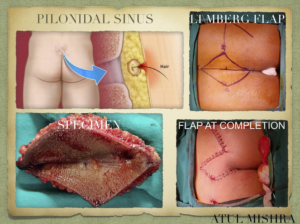
????????? ????? : ??????? ????
A Pilonidal sinus is a small hole or tunnel in the skin. It may fill with fluid or pus causing the formation of a cyst or abscess. It occurs in the cleft at the top of buttocks (sacrococcygeal region). A Pilonidal sinus usually contains hair and debris. The name Pilonidal is taken from Latin meaning “???? ?? ?????”. It can cause severe pain or become infected. It may ooze pus or blood and have a foul odor. It mostly affects men and common in young adults. It is more common in people who sit for long time, like drivers.
??????
It is caused by a combination of changing hormones (puberty), excessive hair growth and friction from clothes or spending long time sitting.
Activities causing friction force the hair growing in the area to burrow back under the skin.
??? ?? ???????? ? ????????? ??????
There may be just a small dimple like depression on the surface of the skin of lower back in the natal cleft. It becomes symptomatic when infected.
The signs of infection include :
• Pain when sitting or standing
• Swelling of cyst
• Reddened or sore skin around the area
• Pus or blood draining from the abscess causing a foul odour
• Hair protruding from the lesion
• Formation of more than one sinus tract, or holes in the skin
????????? ????? ?? ???? ???????? ????? ?? ??????? ????:
• Excessive, coarse, curly or crinkly hair
• Deep natal cleft
• Poor hygiene
• Obesity
• Family predisposition
?????????
The most definite treatment for Pilonidal sinus is surgery.
If there is infection antibiotics can be given. This won’t heal the sinus-tract, but will give relief from the infection and discomfort.
It is recommended to regularly remove hair by clipping or shaving the site and maintain good hygiene.
???????
There are numerous procedures described to treat this condition. The most successful procedure with least recurrence is Limberg flap.
??????? ????
This technique involves wide excision of the area and closing a 60 degree rhombus-shaped defect with a transposition flap. This flap takes the suture line away from midline giving rise to tension free flap of unscarred skin in the midline, which helps in maintenance of wgood hygiene, reduced sweating, maceration, erosion and scar formation. It is superior to primary closure or other flap procedures and a safe & reliable method with low complication and recurrence rate.
?????????? ?? ??????? ????
• The patients get immense relief from the weeping and swollen bottom
• There is no distortion of the contour of the bottom
• This technique is easy to perform in quick time
• Very low complication rate and recurrence
• Quick healing time
• Short hospital stay
• Early return to work and daily activities
????????????? ??????????
Avoid pressure on flap for 3 weeks
??? ?? ??????? ????????? ??????
• Washing the area on a daily basis with a mild soap, making sure all soap is removed
• Keeping the area completely dry
• Avoid sitting continuously for long periods
??? ??? ????? ? ????? ?? ??????? ???? ????????? ?? ? ??????? ?? ????????? ????? ?? ????????? ?? ???? ??????? ?? ??? ??? ???? ???????




